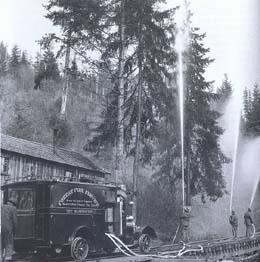On April 6, 1908, 22 timber companies organize the Washington Forest Fire Association, which fields the first organized fire patrol system in the state. Members assess themselves about one-half cent per acre to pay for a force of men to detect and battle fires on members' land. Over the next 50 years, the Association will collaborate with state, and later federal, fire suppression programs and will embark on a campaign to change the logging practices that cause most forest fires.
In 1902, the Yacolt Burn consumed 238,920 acres in Clark, Cowlitz, and Skamania counties and killed at least 38 people. Fires were commonly caused by sparks from steam-powered logging locomotives and machinery, lumber mills, and from burning slash -- the debris left after mature trees are cut. When fires broke out, there was no organized effort to put them out and they were allowed to burn uncontrolled. More timber was being destroyed each year in fires than was being harvested.
In 1903, the State Legislature designated as Commissioner of Public Lands the State Forest Fire Warden to be assisted by county commissioners who were deputy wardens. Without funding or authority, these officials could do little to protect the almost two million acres of timber owned by the state. At the next session in 1905, the Legislature established a State Board of Fire Commissioners, which appointed a State Forest Fire Warden and his deputies. The $7,500 appropriated to fight fires for the biennium ran out the first summer. The commission appealed to private timber interests -- which owned vast tracts of land -- for assistance. A total of $10,300 was raised to fight fires in 1906.
Owners Assess Themselves
In the spring of 1908, leaders in the timber business, including George S. Long (1853-1930) from Weyerhaeuser, mailed 800 letters to timberland owners inviting them to form a voluntary association to suppress forest fires. Twenty-two companies responded and formed the WFFA. That summer, WFFA crews under Chief Fire Warden D. P. Simons patrolled forests and responded to fires. The members assessed themselves ½ cent per acre and managed to recruit a total of 126 members the first year, whose holdings amounted 2.5 million acres of timber. The Chief Fire Warden organized a force of 75 men, each of whom was equipped with an axe, a planter's hoe, and a 10-quart water bag (for the fire crew). Patrolmen were commissioned by the State as Forest-Rangers-at-Large.
The year 1910 was bad for fires, particularly in King, Pierce, and Lewis counties. The State Fire Warden ran out of appropriated funds before the end of the fire season and the lumbermen of the Association stepped in with $10,000 to keep the state crews in the field. The Legislature was slow to fund efforts at suppression and prevention, but the WFFA instituted a program of camp inspections where patrolmen asked operators to use spark arresters on boiler stacks and to limit burning. Prevention became a major part of the WFFA's program. In order to reduce the number of fires caused by wood-burning equipment, the WFFA advocated a shift to fuel oil which was safer and more economical than wood.
In 1911, the U.S. Forest Service began its forest fire program and formal and informal partnerships evolved between private, state, and federal officials. Association patrolmen were commissioned state fire wardens who could issue burn permits, supervise burning, and restrict access to fire hazard areas. Fire wardens were empowered to close down logging operations in high-risk areas.
Compulsory Patrols
In 1917, the Forest Patrol Law required that timberland owners bear the cost of fire control, which increased membership in the WFFA and spread the cost of patrols and suppression more equitably. That year, the amount of timber lost to fire was about one third of that harvested. Fire prevention and protection by the Association eventually included lookout towers, aerial patrols, site inspections, and information campaigns. Combating forest pests with aerial spraying of pesticides became part of the WFFA's mission. When required, wardens personally supervised slash burnings for members. In time, loggers caused fewer fires than did campers, hunters, farmers, and natural forces.
By 1958, the state and federal forest fire programs had evolved to the point that the WFFA was dissolved in favor of the Washington Forest Protection Association.

